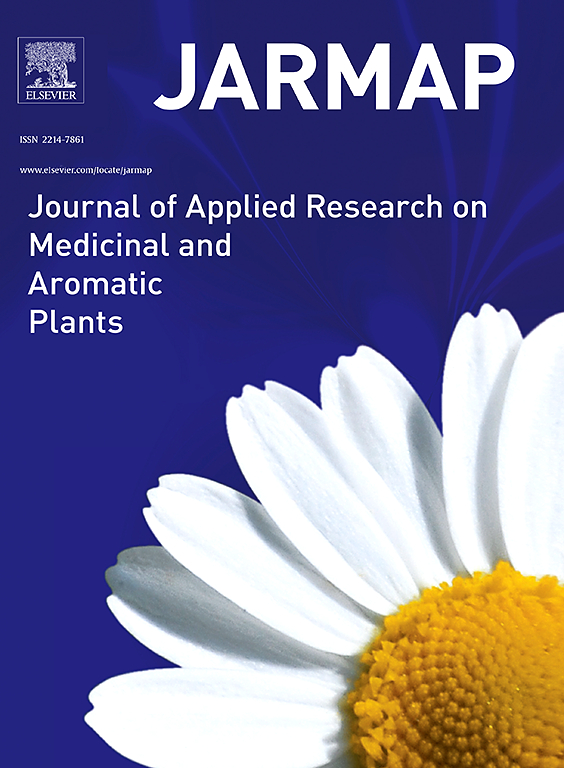纤维素酶辅助加氢精馏工艺优化:响应面法
IF 3.6
2区 农林科学
Q1 PLANT SCIENCES
Journal of Applied Research on Medicinal and Aromatic Plants
Pub Date : 2025-07-08
DOI:10.1016/j.jarmap.2025.100647
引用次数: 0
摘要
Homalomena属的物种自然生长在热带气候中,特别是在高湿度的地区,如越南的热带森林。从该属植物中提取的精油目前被认为是昂贵的。本研究主要对隐花蒿(Homalomena occulta)根茎精油进行了研究。Schott。该研究旨在通过纤维素酶辅助加氢蒸馏优化提取工艺。采用响应面法(RSM)和中心复合设计(CCD),研究了ph、酶浓度和孵育时间对提取率的影响。确定的最佳条件是纤维素酶浓度为0.25 %,pH为3.5,孵育时间为5 h。在此条件下,产量(0.321 ± 0.016 %)比对照(0.100 ± 0.011 %)提高了3倍。当比较未使用纤维素酶提取的精油样品与在最佳条件下使用纤维素酶提取的精油样品时,很明显,从纤维素酶处理的材料中获得的油在不影响质量的情况下具有更高的收率。感官和物理性质基本保持不变;精油保留了透明的淡黄色和甜美清新的香气。然而,从纤维素酶处理的材料样品有更强的木香。其物理性质变化最小,比重分别为0.877 ± 0.0026 g/cm³ 和0.888 ± 0.0016 g/cm³ 。折射率分别为1.4671 ± 0.00020和1.4680 ± 0.00046,旋光角变化不大(-10.388 ± 0.3506 vs - 9.271 ± 0.1851)。黄樟精油中含有丰富的天然芳香族化合物,包括芳樟醇和各种含氧化合物,如松油烯-4-醇、α-松油醇、外皮-α-穆罗、α-二醇等,具有一定的生物学价值和潜在的应用价值。本文章由计算机程序翻译,如有差异,请以英文原文为准。
Optimization of cellulase-assisted hydrodistillation for Homalomena occulta essential oil: A response surface methodology approach
Species belonging to the genus Homalomena naturally grow in tropical climates, particularly in areas with high humidity, such as the tropical forests of Vietnam. Essential oils extracted from plants in this genus are currently considered to be expensive. This study focused on the rhizome essential oil of Homalomena occulta (Lour.) Schott., collected in Gia Lai province, and aimed to optimize the extraction process through cellulase-assisted hydrodistillation. Using response surface methodology (RSM) with a central composite design (CCD), the study evaluated the effects of three factors—pH level, enzyme concentration, and incubation time—on the extraction yield. The optimal conditions identified were a cellulase concentration of 0.25 % at a pH of 3.5 for an incubation period of 5 h. Under these conditions, there was a three-fold increase in yield (0.321 ± 0.016 %) compared to the control (0.100 ± 0.011 %). When comparing essential oil samples extracted without cellulase to those extracted using cellulase under optimal conditions, it was evident that the oils obtained from cellulase-treated materials had a higher yield without compromising quality. The organoleptic and physical properties remained largely unchanged; the essential oil retained a transparent, pale yellow color and a sweet, fresh aroma. However, the sample from the cellulase-treated material had a stronger woody scent. The physical properties demonstrated minimal variation, with specific gravities of 0.877 ± 0.0026 g/cm³ and 0.888 ± 0.0016 g/cm³ , respectively. The refractive indices were 1.4671 ± 0.00020 and 1.4680 ± 0.00046, while the optical rotation angles changed insignificantly (-10.388 ± 0.3506 vs. −9.271 ± 0.1851). The essential oil from Homalomena remains rich in natural aromatic compounds, including linalool and various oxygenated compounds such as terpinene-4-ol, α-terpineol, epi-α-muurol, and α-cadionol, all of which have biological value and potential applications.
求助全文
通过发布文献求助,成功后即可免费获取论文全文。
去求助
来源期刊

Journal of Applied Research on Medicinal and Aromatic Plants
Pharmacology, Toxicology and Pharmaceutics-Drug Discovery
CiteScore
6.40
自引率
7.70%
发文量
80
审稿时长
41 days
期刊介绍:
JARMAP is a peer reviewed and multidisciplinary communication platform, covering all aspects of the raw material supply chain of medicinal and aromatic plants. JARMAP aims to improve production of tailor made commodities by addressing the various requirements of manufacturers of herbal medicines, herbal teas, seasoning herbs, food and feed supplements and cosmetics. JARMAP covers research on genetic resources, breeding, wild-collection, domestication, propagation, cultivation, phytopathology and plant protection, mechanization, conservation, processing, quality assurance, analytics and economics. JARMAP publishes reviews, original research articles and short communications related to research.
 求助内容:
求助内容: 应助结果提醒方式:
应助结果提醒方式:


